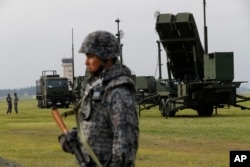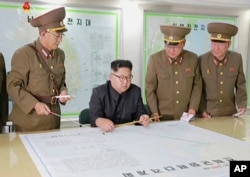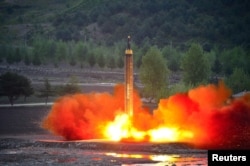North Korea conducted a missile test early Tuesday morning that flew over Japan, one that analysts say was similar to Pyongyang's recently aborted plan to fire a missile near the U.S. territory of Guam, and which prompted sharp reaction from Japanese and other leaders.
The launch is believed to be the second successful test of the Hwasong 12 intermediate-range ballistic missile that can reach distances between 3,000 to 5,000 kilometers (1,800 to 3,100 miles), according to ballistic missile expert Jeffrey Lewis, the director of the East Asia Nonproliferation Program at the Middlebury Institute of International Studies in California. The first successful Hwasong 12 test occurred in May.
The missile passed high above Japan about 10 minutes after launch, split into three pieces and splashed into the Pacific Ocean, east of the northern main Japanese island of Hokkaido, according to Japan's government.
The trajectory triggered satellite-activated emergency alarms to the Japanese public, warning people in the northern Tohoku region to take cover because of a possible impact from a North Korean missile, but no rocket fragments are known to have hit the ground.
Fired from a mobile launch site from Sunan, near Pyongyang's international airport, the missile flew more than 2,700 kilometers (1,700 miles) at a maximum altitude of around 550 kilometers (340 miles), according to the South Korean Joint Chiefs of Staff.
Many of North Korea's recent missile tests were launched from different mobile launch sites across the country, making them more difficult to target than one stationary launch site.
Test draws sharp reaction
Japanese Chief Cabinet Secretary Yoshihide Suga condemned the latest North Korean missile test that entered the country's airspace as “the greatest and serious threat to the nation ever” and said Tokyo will work with the United States and United Nations Security Council to further increase economic and diplomatic pressure on Pyongyang.
“We find these repeated threats by North Korea unacceptable and have strongly protested to North Korea in the strongest possible words,” said Suga.
U.S. Army Col. Robert Manning, a spokesman at the Pentagon, said the launch “did not pose a threat to North America.”
South Korean fighter jets conducted bombing drills in response to Pyongyang's missile launch, according to a presidential spokesman at the Blue House. Leaders in Washington and Seoul also agreed to seek increased economic sanctions on North Korea, just weeks after the United Nations imposed new punitive measures that included a export ban on fish, coal and other lucrative minerals that could deprive Pyongyang of over $1 billion in revenue.
Chinese Foreign Ministry spokeswoman Hua Chunying said sanctions and pressure alone cannot fundamentally resolve the issue, while issuing China's usual call for restraint from all those involved.
Speaking to the RIA Novosti news agency, Russian Deputy Foreign Minister Sergei Ryabkov said Russia is "extremely concerned by the general developments" and sees "a tendency towards an escalation."
Guam substitute test
Lewis said the Hwasong 12 was likely the missile that North Korea was planning to launch earlier in August toward the U.S. territory of Guam, where a major American military base is located. North Korean leader Kim Jong Un decided to delay that test after U.S. President Donald Trump threatened to respond with "fire and fury" to any attack on U.S. territory.
“They sort of backed down but I am guessing they substituted this instead. So it's some of the provocation but not all of it,” said Lewis.
Missile defense
Japanese authorities say their anti-missile batteries made no attempt to shoot down the projectile. Japan has in the past vowed to shoot down North Korean missiles or rockets that appeared likely to hit its territory, and deployed its Patriot missile defense system in response to the threat against Guam.
However analysts say Japan does not have a reliable capability to target a high altitude missile mid-flight. The Patriot system only intercepts low-altitude incoming missiles and Tokyo's Aegis missile defense system, like the THAAD missile defense battery in South Korea, is designed to stop missiles in their descent phase.
Tensions resume
This latest launch came just days after Pyongyang test fired three short-range missiles at the beginning of joint military exercises by American and South Korean military forces.
The launch also ended a month-long hiatus in missile tests, which U.S. officials interpreted as “restraint” and prompted President Donald Trump last week to say that North Korean leader Kim Jong Un was “starting to respect us.”
“Anyone who believes that somehow North Korea would abandon these capabilities or change their intentions regarding the acquisition of these capabilities, I just think that is very far-fetched and unlikely,” said Northeast Asia security analyst Daniel Pinkston with Troy University in Seoul.
An annual joint defense exercise, Ulchi Freedom Guardian between the South Korean and U.S. forces, is under way on the Korean peninsula. These exercises always prompt strong protests from Pyongyang and frequent provocations.
ICBM progress
The new launch is also different from two launches last month that Pyongyang claimed were intercontinental ballistic missiles with a range long enough to reach the continental United States. Those ICBMs were fired into steeply lofted ballistic paths that kept the rockets from overflying Japan.
Experts say at this point North Korea's ICBM capability is unreliable and needs further testing to improve its accuracy and to demonstrate the ability to incorporate a miniaturized nuclear warhead to become a verifiable threat. However with each missile test Pyongyang moves closer to achieving its goal.
“I think we transitioned from a period from which they're figuring it out to a period in which they are perfecting it,” said ballistic missile expert Lewis.
Tuesday's incident recalled the over flight of Japan by a North Korean missile in 1998 as well as another launch in 2009, a purported attempt to send a satellite into Earth orbit, in which a multistage rocket passed over Japanese territory.
White House Bureau Chief Correspondent Steve Herman and National Security Correspondent Jeff Seldin contributed to this report













